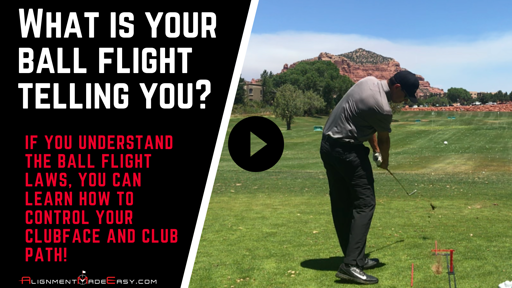
Understand your Ball Flight to Improve your Game!
Understand your Ball Flight to Improve your Game!
Now that you're connected to where you want to go and accurately set up for the shot that you created in your mind, you should see an improvement in your shot pattern. By picturing what you want to happen before it happens, you increase the likelihood of hitting a good shot.
It doesn't guarantee a good shot, but setting up with consistency and accuracy will allow you to learn from the shots that you hit. In this video, I'll teach you how to understand your ball flight to improve your swing.
Your swing can change from day to day, so it's essential to know how to make the right adjustments to control your ball flight. If you understand the ball flight laws, you can learn from each shot that you hit. Here are three questions to ask yourself after each shot.
- Did you hit the ball in the center of the clubface? Hitting the ball off of the toe or the heel can impact your ball flight. It's called gear effect. Toed shots tend to start right and draw, heeled shots tend to start left and fade. If you don't hit the shot solid, don't read too much into the ball flight. If you do hit a flush shot, ask yourself the next two questions.
- What direction did the ball start? The initial starting direction of the ball helps you understand where your clubface is aimed at impact. The club path has a small effect, but the face angle is the majority. For a driver, the clubface angle at impact is 85% of the initial starting direction of the ball, for an iron, it's 75%.
- What direction did the ball curve? Watching the way the ball curves will help you understand your club path. If the ball fades or slices, the club path was traveling left of the clubface at impact. If the ball draws or hooks, the club path was moving right of the clubface angle at impact.
Learning from your ball flight allows you to bring out your athletic ability to control your clubface and club path. If you're throwing a ball or shooting a basket and the ball keeps going right of the target, you quickly understand what's happening and make the necessary adjustments. It's not as simple in golf, but if you learn from your ball flight, you can create the right feelings to control your clubface and club path.
Here are some ball flight examples for a right-handed golfer:
The ball starts right and flies straight: Clubface is aimed right of the start line at impact, and the path is square to the clubface.
The ball starts right and slices: Clubface is aimed right of the start line at impact, and the path is moving left of the clubface.
The ball starts right and hooks: Clubface is aimed right of the start line at impact, and the path is moving too far right of the clubface.
Perfect draw: Clubface is square to your start line (right of your end target) at impact, and the path is moving the ideal amount right of the clubface.
The ball starts left and flies straight: Clubface is aimed left of the start line at impact, and the path is square to the clubface.
The ball starts left and slices: Clubface is aimed left of the start line at impact, and the path is moving too far left of the clubface.
The ball starts left and hooks: Clubface is aimed left of the start line at impact, and the path is moving right of the clubface.
Perfect fade: Clubface is square to your start line (left of your end target) at impact, and the path is moving the ideal amount left of the clubface.
Straight shot: Clubface is square to your start line (directly at your end target) at impact, and the path is moving square to the clubface.

